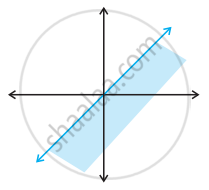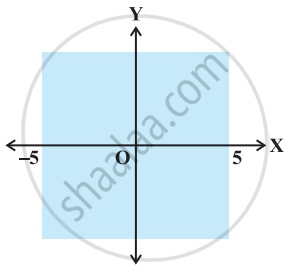Advertisements
Advertisements
प्रश्न
Represent to solution set of each of the following inequations graphically in two dimensional plane:
3x − 2y ≤ x + y − 8
उत्तर
Converting the inequation to equation, we obtain 3x\[-\] 2y\[-\] x\[-\]y + 8 = 0, i.e 2x\[-\] 3y+ 8= 0
Putting y =0 and x = 0 in this equation, we obtain x = \[-\]and y = 8/3 respectively.
So, this line meets the x-axis at (\[-\]4, 0) and y-axis at (0,8/3).
We plot these points and join them by a thick line.
This divides the xy plane into two parts.
To determine the region represented by the given inequality, consider point O(0,0).
Clearly, (0,0) does not satisfy the inequality.
So, the region that does not contain the origin is represented by the given inequality.
Hence, the shaded region is the solution to the inequation.

APPEARS IN
संबंधित प्रश्न
Solve 24x < 100, when x is a natural number.
Solve –12x > 30, when x is an integer.
Solve 5x – 3 < 7, when x is a real number.
Solve the given inequality for real x: 3x – 7 > 5x – 1.
Solve the given inequality for real x: x + `x/2` + `x/3` < 11
Solve the given inequality for real x : `x/3 > x/2 + 1`
Solve the given inequality for real x: `(3(x-2))/5 <= (5(2-x))/3`
Solve the given inequality for real x: `1/2 ((3x)/5 + 4) >= 1/3 (x -6)`
Solve the given inequality for real x: 2(2x + 3) – 10 < 6 (x – 2)
Solve the given inequality for real x: `x/4 < (5x - 2)/3 - (7x - 3)/5`
Solve the given inequality and show the graph of the solution on number line:
3x – 2 < 2x +1
Solve the given inequality and show the graph of the solution on number line:
3(1 – x) < 2 (x + 4)
Find all pairs of consecutive odd positive integers both of which are smaller than 10 such that their sum is more than 11.
Find all pairs of consecutive even positive integers, both of which are larger than 5 such that their sum is less than 23.
The longest side of a triangle is 3 times the shortest side and the third side is 2 cm shorter than the longest side. If the perimeter of the triangle is at least 61 cm, find the minimum length of the shortest side.
Solve the inequality.
`-12 < 4 - (3x)/(-5) <= 2`
Solve the inequality.
`7 <= (3x + 11)/2 <= 11`
Represent to solution set of each of the following inequations graphically in two dimensional plane:
x + 2y − y ≤ 0
Represent to solution set of each of the following in equations graphically in two dimensional plane:
2. x + 2y ≥ 6
Represent to solution set of each of the following inequations graphically in two dimensional plane:
x + 2 ≥ 0
Represent to solution set of each of the following inequations graphically in two dimensional plane:
5. −3x + 2y ≤ 6
Represent to solution set of each of the following inequations graphically in two dimensional plane:
6. x ≤ 8 − 4y
Represent to solution set of each of the following inequations graphically in two dimensional plane:
y ≥ 2x − 8
State whether the following statement is True or False.
If xy < 0, then x > 0, and y > 0
State whether the following statement is True or False.
If |x| < 5, then x ∈ (–5, 5)
State whether the following statement is True or False.
Solution set of x – y ≤ 0 is

The inequality representing the following graph is ______.
Solution of a linear inequality in variable x is represented on number line given below ______.

Solution of a linear inequality in variable x is represented on number line given below ______.

If |x| > 5, then x ∈ (– `oo`, – 5) ∪ [5, `oo`)
If |x| ≤ 4, then x ∈ [– 4, 4]
